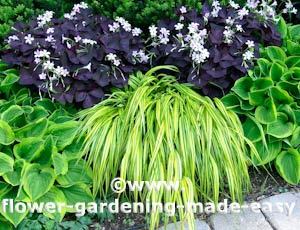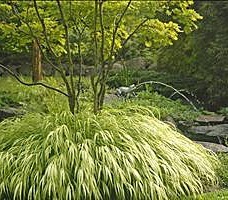One of my favorite plants, Golden Hakone Grass (Hakonechloa macra ‘Aureola’) was voted Perennial Plant of the Year in 2009.
In my garden I team this ornamental grass with gold-tinged ‘Golden Tiara’ hosta and purple-leaved oxalis, a non-hardy summer bulb plant. The grouping at my side entry garden (shown below) looks lovely all season long.
Hakonechloa macra ‘Aureola’ – background

Golden Hakone Grass
(Hakonechloa macra ‘Aureola’)
This species of grass is native to Japan’s main Island, Honshu, and gets its name from the region near Mt. Hakone. Chloa is the Greek word for grass.
This is the second ornamental grass to be chosen as a Perennial Plant of the Year. Calamagrostis x acutiflora ‘Karl Foerster’, feather reed grass, was chosen in 2001.
How to grow Golden Hakone Grass
Hardiness: USDA zones 5-9.
Size and growth habit: This grass grows 12 to 18 inches tall and 18 to 24 inches wide, and its leaves fall attractively in one direction.
The bright yellow foliage is 1/2″ wide with thin green stripes, and in the fall becomes tinged pink and red.
Golden hakone grass spreads by rhizomes and stolons, but grows so slowly that it does not becomes a rampant spreader. Slow growth means that you don’t need to divide it for many years.
However, if you wish to divide to obtain more plants, as with other ornamental grasses, the best time to do this is in early spring just as new growth starts.
Light and soil conditions: This ornamental grass grows well in partial shade, especially in hot climates, but it can take more sun in cooler areas. Plant in moist, humus-rich, well-drained soil.
The Perennial Plant Association recommends not planting it in poorly drained soil, heavy clay or excessively dry and sandy soils. However, I’ve had several readers tell me they have it in moist clay areas, where it grows well.
In its native habitat, the growing conditions are wet, rocky cliffs, so this plant appears to be quite adaptable.
Maintenance: Golden Hakone grass is a shade tolerant grass and has few insect or disease problems. Even deer tend to leave it alone.
The only maintenance required is to cut the previous season’s dead leaves back in fall, late winter or early spring.
This grass has shallow roots, and therefore is best divided in spring, like most grasses. If divided in fall, the divisions are prone to cold weather damage and frost heaving.

Golden Hakone Grass
(Hakonechloa macra ‘Aureola’)
Photo courtesy of Walters Gardens, Inc.
Garden uses: This perennial grass makes a great companion for hostas, especially hostas with gold variegation, or bluish leaves.
Other good matches with perennials include foam flower (Tiarella cultivars) and Heucheras, especially those with purple leaves, and purple leaved bugbane cultivars (Actaea, also known as Cimicifuga), such as ‘Hillside Black Beauty’ and ‘Brunette’.
Golden Hakone Grass also looks great with astilbe, epimedium, wild ginger, bleeding heart and lady’s mantle.
I’ve also grown it as a container plant and love the way it cascades over one side like a waterfall. My favorite way to use it in my garden beds is as an edger where its foliage can cascade onto a path.
Other Hakonechloa varieties
- Hakonechloa macra ‘Albo Striata’ (‘Albovariegata’): Has white stripes on green leaves; is a bit more sun tolerant than gold variegated type; grows a little faster.
- H. m. ‘All Gold’: This cultivar comes from Terra Nova Nurseries; has a more upright and spiky growth habit and bright gold leaves; slow growing.
- H. m. ‘Beni Kaze’ (‘Benikaze’): The cultivar name means red wind in Japanese; leaves are green, turn reddish in the fall.
Related Information
How to plant and care for ornamental grasses
Prairie-style gardening with grasses and native wildflowers
Go from Golden Hakone Grass back to Ornamental Grasses for Shade




